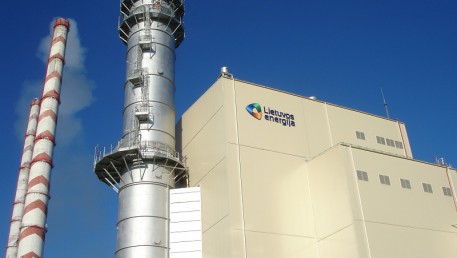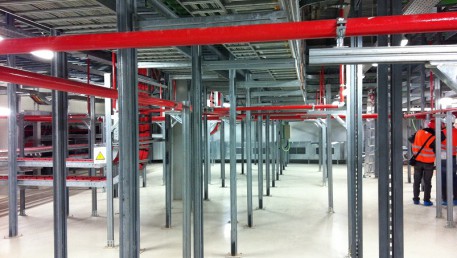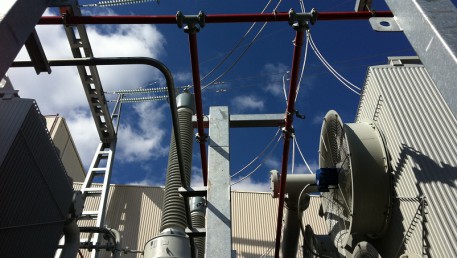
Fire detection and extinguishing solutions in the Lithuanian Power Plant’s combined cycle block
- Client Lietuvos energija
- Implementation period 2010 - 2012
- Project location Elektrėnai, Lithuania
- Project partners IBERDROLA Ingenieria y Construccion S.A.U.
- Project task Installing an integrated fire fighting solution in the newly-built combined cycle block at the Lithuanian power plant.
Solutions in this project
- Fire detection systems
- Gas leak detection systems
- Gas-based fire suppression system
- Foam-based fire suppression system
- Water-based fire suppression system
- Fire sealing
FIMA specialists, who were responsible for overall fire safety in the block, installed all the necessary systems including fire alarms, gas leak detection and extinguishing systems.
During the construction of the Lithuanian power plant’s 455 MW combined cycle block, FIMA specialists were responsible for overall fire safety, installing all of the necessary solutions including fire alarms, gas leak detection and extinguishing systems.
To protect against what could be different fire sources, FIMA installed several extinguishing systems in the block. In areas where there could be a build-up of gas, automatic gas detection and CO2 gas extinguishing systems were installed along with a foam-based fire suppression system in areas that house oil filtering systems. Should fires break out in transformers, a diesel generator, a turbine bearing system or cable housings then water would be used to extinguish them while a fire in cabling would be put out using FM200 gas.
Gas leaks or the build-up of hazardous amounts of gas are detected by gas composition analysers. Depending on the concentration of dangerous gas detected in an area, the system is able to send out different types of alert: warning of a leak, a hazardous build-up of gas warning and a danger alarm.
Outdoor fire detectors ensure that staff is able to take rapid action should a fire break out in high-voltage transformers. There are also smoke and temperature sensors in indoor areas. In many parts of the block, the extinguishing systems are triggered automatically by fire alarms when more than one detector detects a fire.
Where erroneous self-activation could incur substantial costs, the systems are duplicated.
FACTS
- FIMA installed six different types of extinguishing system in the block:
- CO2 gas-based suppression
- FM200 gas-based suppression
- Foam-based suppression
- Sprinkler
- Drench
- Fire hydrants
- Extinguishing systems cover 11 different areas and premises
- More than 15 km of cabling was used for the fire detection and gas leak alarm systems
- More than 1,200 square metres of fire sealing were installed
- All of the systems were activated and tested for reliability
Related projects
-
 Technology infrastructure solutions at Latvian shopping centre Akropolis
Technology infrastructure solutions at Latvian shopping centre Akropolis
-
 Fire protection system of the Lithuanian Central State Archives
Fire protection system of the Lithuanian Central State Archives
-
 An integrated solution for the surveillance and control of the EU border with Russia and Belarus
An integrated solution for the surveillance and control of the EU border with Russia and Belarus
-
 Server room infrastructure for the new TV studio of Latvian National Television
Server room infrastructure for the new TV studio of Latvian National Television
-
 Security system at the liquefied natural gas (LNG) terminal in Klaipėda
Security system at the liquefied natural gas (LNG) terminal in Klaipėda
-
 Equipping a functional fire station at Vilnius Airport
Equipping a functional fire station at Vilnius Airport
-
 Modernising East–West railway corridor
Modernising East–West railway corridor
-
 Fire extinguishing system at IKEA plywood factory
Fire extinguishing system at IKEA plywood factory
-
 Engineering systems at a water park in Minsk
Engineering systems at a water park in Minsk
-
 Reconstruction of LESTO substation control systems
Reconstruction of LESTO substation control systems
-
 Ionising radiation detection system at Klaipėda Seaport
Ionising radiation detection system at Klaipėda Seaport
-
 Modernisation of traffic control, telecommunications and power supply systems on Lithuanian Railways’ IX D corridor
Modernisation of traffic control, telecommunications and power supply systems on Lithuanian Railways’ IX D corridor
-
 Safety solutions for biofuel and waste-to-energy co-generation plant run by Fortum Klaipėda
Safety solutions for biofuel and waste-to-energy co-generation plant run by Fortum Klaipėda
-
 Fire suppression solutions in the new Information and Communication Centre for Scholars at Vilnius University Library
Fire suppression solutions in the new Information and Communication Centre for Scholars at Vilnius University Library
-
 Cabling infrastructure system at Microsoft’s Lithuanian office
Cabling infrastructure system at Microsoft’s Lithuanian office
-
 Engineering solutions for GECO biofuel plant in Kaunas
Engineering solutions for GECO biofuel plant in Kaunas
-
 Indoor positioning system to locate staff in a psychiatric hospital
Indoor positioning system to locate staff in a psychiatric hospital
-
 Construction of a public health laboratory of Biosafety Level 3
Construction of a public health laboratory of Biosafety Level 3
-
 Telecommunications and security systems in RIMI shopping centres
Telecommunications and security systems in RIMI shopping centres
-
 Transit trains surveillance system on the line to Kaliningrad
Transit trains surveillance system on the line to Kaliningrad
-
 Access control system for Minsk Automobile Plant
Access control system for Minsk Automobile Plant
-
 Solutions for Centralised traffic control in Vilnius
Solutions for Centralised traffic control in Vilnius
-
 Installation and maintenance of engineering systems in the Šiauliai arena
Installation and maintenance of engineering systems in the Šiauliai arena
-
 Electronic perimeter security system at an oil terminal
Electronic perimeter security system at an oil terminal
-
 Integrated engineering systems for the CIDO universal sports arena
Integrated engineering systems for the CIDO universal sports arena
-
 CCTV in the town of Klaipėda
CCTV in the town of Klaipėda
-
 Security system in Rokiškis psychiatric hospital
Security system in Rokiškis psychiatric hospital
-
 Security solutions for a snow arena in Druskininkai
Security solutions for a snow arena in Druskininkai
-
 An engineering systems solution for the new Lithuanian Parliament chamber
An engineering systems solution for the new Lithuanian Parliament chamber
-
 Integrated project to install engineering systems in the Stasylos railway border inspection post
Integrated project to install engineering systems in the Stasylos railway border inspection post
-
 Engineering Solutions in Kaunas rail tunnel
Engineering Solutions in Kaunas rail tunnel
-
 Passenger Terminal Engineering Systems at Palanga Airport
Passenger Terminal Engineering Systems at Palanga Airport
-
 Engineering systems in the new terminal at Vilnius International Airport
Engineering systems in the new terminal at Vilnius International Airport
-
 Reconstruction of substations and power distribution station for Lietuvos energija
Reconstruction of substations and power distribution station for Lietuvos energija
-
 Reconstruction of substation control systems in the Kėdainiai and Rokiškis regions
Reconstruction of substation control systems in the Kėdainiai and Rokiškis regions
-
 Server room infrastructure for Danske Bank
Server room infrastructure for Danske Bank
-
 DNB Bank offices security and information systems
DNB Bank offices security and information systems
-
 Integrated security system for SEB Bank
Integrated security system for SEB Bank
-
 Fire extinguishing system in an Intersurgical plant
Fire extinguishing system in an Intersurgical plant
-
 Security and building management system in the EUROPA shopping centre
Security and building management system in the EUROPA shopping centre
-
 Vilnius video surveillance system
Vilnius video surveillance system
-
-
Testimonials
-
FIMA is known as a company that is able to adjust to frequent changes, which are inevitable in projects of such a scale, and react to unpredicted situations. In my opinion, in some of these situations the solutions offered by Fima specialists were particularly important, as they allowed us to complete the project on time and to implement all client’s quality requirements.



